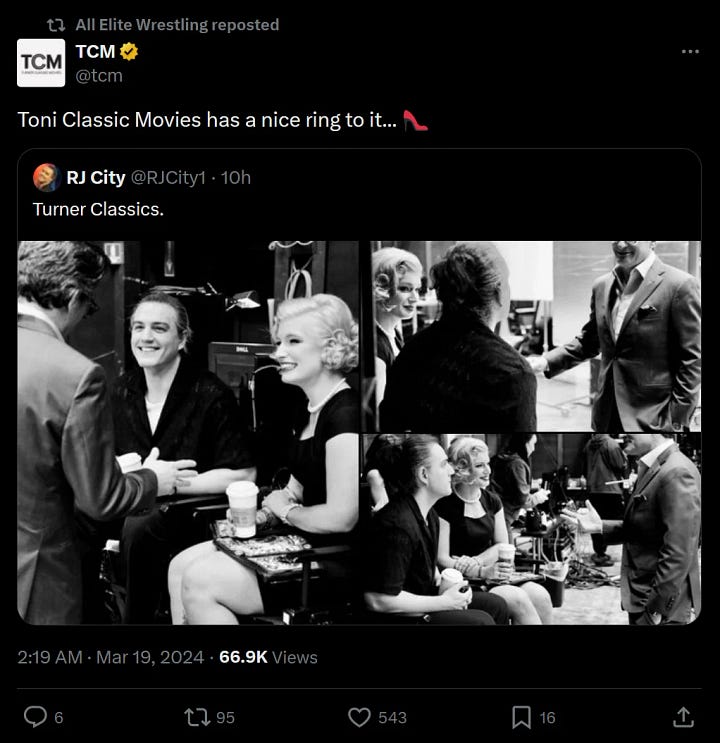The AEW-TCM Collab Shows That Corporate Synergy Can Be Good
More crossovers between classic Hollywood cinema and pro wrestling, please.
Pro wrestling exists its own bizarre reality where employees handle their workplace disagreements in a “squared circle,” but that doesn’t keep other media figures from visiting. Sometimes, the visits are fun and narratively meaningful, like with then-WWF’s genius partnership with MTV and pop stars like Cyndi Lauper in the lead-up to the first WrestleMania. Other times, they reveal how Hollywood’s promotional machinery doesn’t quite graft onto a live wrestling show, like when WWE rotated celebrity guest hosts for Raw between 2009 and 2010.
WWF/E hoped big-time stars would bring some additional legitimacy and eyeballs to its culturally maligned product in both cases. But a long-term storyline in All Elite Wrestling (AEW), WWE’s main competitor, demonstrates that celebrities with smaller but pointed areas of influence can work well—especially when part of a tongue-in-cheek round of corporate synergy.
Last summer, AEW Women’s World Champion Toni Storm lost her title and then her mind. The Aussie performed as a tough type for ages, complete with “rocker chic” costuming (studded gear, backward flat bill hat, long hair) and an aggressive, if bland, character. After her big loss and a subsequent betrayal from a friend, Storm appeared in flowing robes and her hair in a curled bob. Storm suddenly spoke with a transatlantic Hollywood accent to talk about her stardom and opponents going “completely off-script” for failing to “remember [their part] in my performance.”
“Timeless” Toni Storm was an immediate hit with AEW fans thanks to Storm’s charming pivot and sharp production changes. Storm’s television segments began to be colorized in black and white. She pulled the cameras closer to exclaim that she was “ready for her close-up” and cued commercial breaks with “And now, words from our sponsors.” She went full Gloria Swanson/Norma Desmond.
Pro wrestling can withstand this kind of character because everyone watching is already in on the joke. We know it’s not “real,” so it doesn’t matter that a character suddenly gets the black-and-white filter. Timeless Toni is broad enough that most viewers get the classical Hollywood reference even if they’re unaware of the specific inspirations. But for the smaller number of viewers who fall in the middle of a “pro wrestling” and “Hollywood history” Venn diagram, the evolution of the character to include even more references is a pure delight.
When Storm won her title back in November, she didn’t have a traditional celebration. Instead, AEW interviewers RJ City and Renee Paquette “announced” her win as if it were the Oscars. Storm gave a speech.
But the next week was even better. Ben Mankiewicz of Turner Classic Movies introduced Storm just as he would introduce a Golden Age of Hollywood moving picture on TCM: “Every generation, a performer comes along and redefines what it means to be human.” Mankiewicz’s earnest appraisal of Storm’s career—placing her in a pantheon with Garbo, Brando, and Groucho—made her gauzy entrance even more ridiculous, and thus so much better.
Since then, AEW and TCM have continued their partnership in social media content. Mankiewicz appeared in a short video to promote City’s YouTube show, “Hey (EW)!” Storm and City promoted TCM merch on Instagram. Storm shot a promo video for this Spring’s TCM Film Festival. And she and Mankiewicz did a quick video for Twitter that the @TCM retweeted simply with, “CINEMAAAAA.”




Based on a Twitter exchange between Mankiewicz and AEW boss Tony Khan after Mank’s first appearance, it seems like the former simply did a favor for the latter rather than this being a corporate directive from Warner Bros. Discovery. That’s probably doubly true since WBD hasn’t shown a lot of outwardly positive enthusiasm for TCM or AEW since the David Zaslov regime began.
However, the AEW-TCM collaborations are only possible because of shared corporate ownership. They’re a great representation of what social media output should look like: they’re silly but not overloaded with meaning. The interactions serve no real financial purpose for either company and only expand the parameters of AEW’s storytelling universe just a little bit. They’re just fun.
This is TV Plus, a newsletter about television written by Cory Barker, a media studies professor and veteran blogger. You can follow me on Twitter, Instagram, Threads, and Bluesky, or email me at barkerc65[at]gmail.com. Thanks for tuning in.





